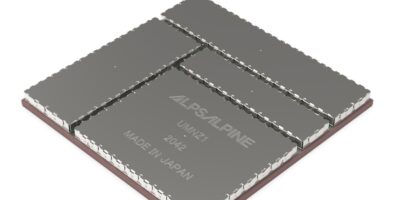Obstacles to overcome in automotive communication systems that make use of V2X (vehicle to everything) systems and 5G technology are raising communication functionality to meet V2X’s complex processing that can lead to modules overheating. Modules also tend to get bigger with increased functionality, creating a need to optimise module design for mounting to customer circuits. This complex task is a major barrier to commercialisation, says Alps Alpine.
The UMNZ1 Series 5G NR module for automotive use with C-V2X features complies with 3GPP Release 15. Suppressing heat generation and employing an original structure for greater dissipation of heat inside systems after mounting is claimed to maximise performance. The module is flat, for stability in mounting the device, says the company and it is compatible with frequencies used by specifications worldwide. The UMNZ1 Series module also have optional compatibility with dual SIM dual active (DSDA) devices.
Principal applications are telematics control units (TCUs), V2X on-board units (OBUs) and V2X road-side units (RSUs).
Samples are shipping now for customers to implement in communication solutions based on V2X systems and 5G.
Alps Alpine specialises in Bluetooth and Wi-Fi technology for automotive product development and developing technology for the C-V2X domain, particularly in China, which leads the world in C-V2X deployment. Teaming up with a Chinese C-V2X chip supplier under a mutually complementary production and development partnership agreement, Alps Alpine developed an All In One communication module with a built-in V2X protocol stack and has been involved in interoperability testing in China, as well as ongoing demonstration testing within Wuxi’s designated C-V2X zone.
On January 1, 2019, Alps Electric and Alpine Electronics integrated their businesses and became Alps Alpine. The new company serves the automotive market, mobile devices and consumer electronics, as well as new sectors such as energy, healthcare and industry.
Since 2013 the European head office has been located in Munich and as such co-ordinates the sales, marketing and product engineering activities of offices in Dusseldorf, Stuttgart, Wolfsburg, Paris, Milton Keynes, Coventry, Gothenburg, Frolunda and Milan, as well as the production activities of our manufacturing site in Dortmund.







